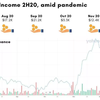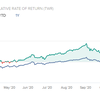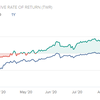Investing in Top Growth Stocks with Huge Disruptive Potential
Growth investing has been extremely profitable with growth funds such as Cathie Wood’s ARK Innovation ETF (ARKK) surging over 200% over the last year.
The performance of growth funds have been attributed to disruptive growth stocks that are able to take advantage of opportunities from record-breaking technological changes. These companies have the potential to change their industry’s landscape by creating simplicity and accessibility while driving down costs with their technologically enabled product or service.
The current pull back we are seeing in the market presents an attractive buying opportunity for long term investors looking to gain exposure to these disruptive growth stocks. Today, we will explore the characteristics of growth stocks and discuss how we can identify top growth stocks that are revolutionizing their industry.
What is a growth stock?
Growth stocks are companies that increase both their revenue and earnings at a faster rate than most stocks in their industry. These companies are able to generate exponential growth by developing an innovative product or service that is able to gain market share from its competitors or creating entirely new industries.
These high growth stocks are rewarded by the market, delivering huge returns to shareholders in the process. The faster their growth, the bigger their returns.
In contrast with value stocks, high growth stocks are relatively more expensive with higher price to earnings ratio (P/E Ratio) and price to sales ratio (P/S Ratio). However, even though growth stocks are expensive relative to the current earnings, the best growth stocks can still provide huge returns to investors when they realise their growth potential.
How do we find growth stocks?
With thousands of stocks to choose from, how do we identify the best growth stocks to invest in 2021?
We can use a screening tool, to scan thousands of stocks in the market and filter stocks with strong revenue growth. Using this list of fastest growing stocks today, we run a fundamentals backtest to further select the top growth stocks for our portfolio. Finally, qualitative investors may also further enhance the selection of growth stocks using fundamental analysis. Tools such as bots and web apps are able to automate this investing process.
Screening for our universe of growth stocks
Head over to the screening tool where we will be screening for our investment universe of growth stocks.
In our screen, we will be filtering for:
-
Stocks in the US market
-
Stocks that are mid cap sized and above
-
Stocks with a revenue growth greater than 20%
In the Region field, select US Stock. Under Market Cap, check the mega cap, large cap and mid cap check boxes. Click on Add another filter and select revenue growth. A new revenue growth field will appear where we will select stocks with a revenue growth greater than 20%. Finally, click on the blue button to find your stocks.
This will generate a list of over 500 stocks that pass our screening criteria. In the list we can see stocks such as Apple that had a revenue growth of 21.4% in the last year. Click on the button to create a backtest with screen results.
You will see a pop up with the option to create a backtest using your screen results. We are going to select the top 250 stocks from our screen results with the highest revenue growth to run a fundamentals backtest. Once you have selected these parameters in the dropdown menus, click on the blue button to create your fundamentals backtest.
Backtesting our growth investing strategy
You will be directed to the fundamentals backtest page, where the investment universe has been pre-populated with the 250 stocks from our screen with the highest revenue growth.
Scroll down to the next section, where we will select the signals for our fundamentals backtest to build our portfolio of top growth stocks.
We are going to select 3 signals to rank our stocks - revenue growth, profit growth and price to sales ratio (P/S ratio). Besides, using growth metrics such as revenue growth and profit growth to select the fastest growing companies, we also want to look at valuation to ensure that our stocks are not excessively overvalued relative to their sales.
We use the price to sales ratio instead of the price to earnings ratio (P/E ratio) because a number of these growth companies are not profitable yet. They are spending a lot of money on areas such as marketing to increase their growth. Because their earnings are negative, their P/E ratio is not defined. Hence we use the price to sales ratio to gauge the company’s valuation relative to their sales. We want companies with the lowest price to sales ratio because they are cheap relative to their sales with strong upside potential.
These signals are normalized such that they are comparable with each other and assigned a weight of 33% each where we equal weight each of these signals. These signals are combined together to form our overall signal used to rank all 250 stocks in our investment universe allowing us to select the best growth stocks for our portfolio.
Next, select the number of stocks to include in your portfolio. We are going to select 30 stocks in our portfolio where each stock is equally weighted at 3.3%. This is to ensure that our portfolio is diversified with low concentration risk. We are not gambling on a single stock going up big. Instead, we are betting that growth stocks on average are able to outperform the market.
Our rebalance frequency will be set to a monthly frequency to prevent excessive trading and reduce transaction cost. Every month, 250 stocks will be ranked using the signals we selected (profit growth, revenue growth and price to sales ratio) and the top 30 stocks will be selected to form our portfolio.
Finally hit the run backtest button to run your growth investing strategy.
The strategy has an annualized return of 32%, a volatility of 25% and a max drawdown of 39%.
Comparing the strategy against Cathie Wood’s ARK Innovation ETF (ARKK), we can see that there is significant correlation in their performance. This is due to similar exposure to growth stocks between the 2 strategies. While ARKK has a higher annualized return of 34%, our strategy has a higher risk adjusted return reflected from its higher Sharpe ratio (1.08 vs 0.99).
Scrolling down, you will see a list of stocks in the strategy’s current portfolio and the weight of each stock in the portfolio. These are the top growth stocks selected by the model based on the signals we chose for our growth investing strategy.
For quantitative investors who prefer relying on a fully systematic strategy without any human intervention, you can choose to invest in all 30 stocks from your backtest portfolio.
Fundamental analysis of growth stocks
Qualitative investors who prefer looking at the business model and growth potential of a stock can do additional fundamental analysis to further narrow down this list of 30 stocks down to 15 to 20 stocks.
One possible way to analyze these stocks is to find stocks that are best positioned to profit from strong market trends. Companies that are able to take advantage of these trends can exponentially grow their profits, generating huge returns for investors.
For example, one of the stocks selected by our model was Fiverr. Fiverr is a global online marketplace for freelancers in creative industries. Freelancers provide a wide number of services such as developing a new website, creating a new logo, editing a video and writing for blogs. With the huge tailwinds due to the work from home trend and the gig economy expected to grow to $100b in the US market, Fiverr’s revenue growth has been accelerating to over 80% year over year.
Another method of analyzing stocks would be to search for companies with strong economic moats that can maintain their competitive advantage and protect their profits and market share from their competitors.
A great example of such a company selected by the model is CrowdStrike. CrowdStrike is a growth leader in cyber security with a disruptive business model in endpoint security. CrowdStrike uses artificial intelligence to learn from previous cyber attacks, allowing its platform to adapt and provide robust cybersecurity solutions. The company’s superior technology is a strong economic moat that creates an effective barrier against its competitors, preventing them from seizing their market share.
Conclusion
Investing in growth stocks can be extremely profitable for long term investors looking to participate in the exponential growth of disruptive companies. We discussed how to build a portfolio of top growth stocks using a screening tool and a fundamentals backtest. We also looked at how qualitative investors can further narrow the stock selection using fundamental analysis. We hope that you will be able to use this stock selection method to profit from growth investing.
Happy investing, and may the odds be in your favor.













